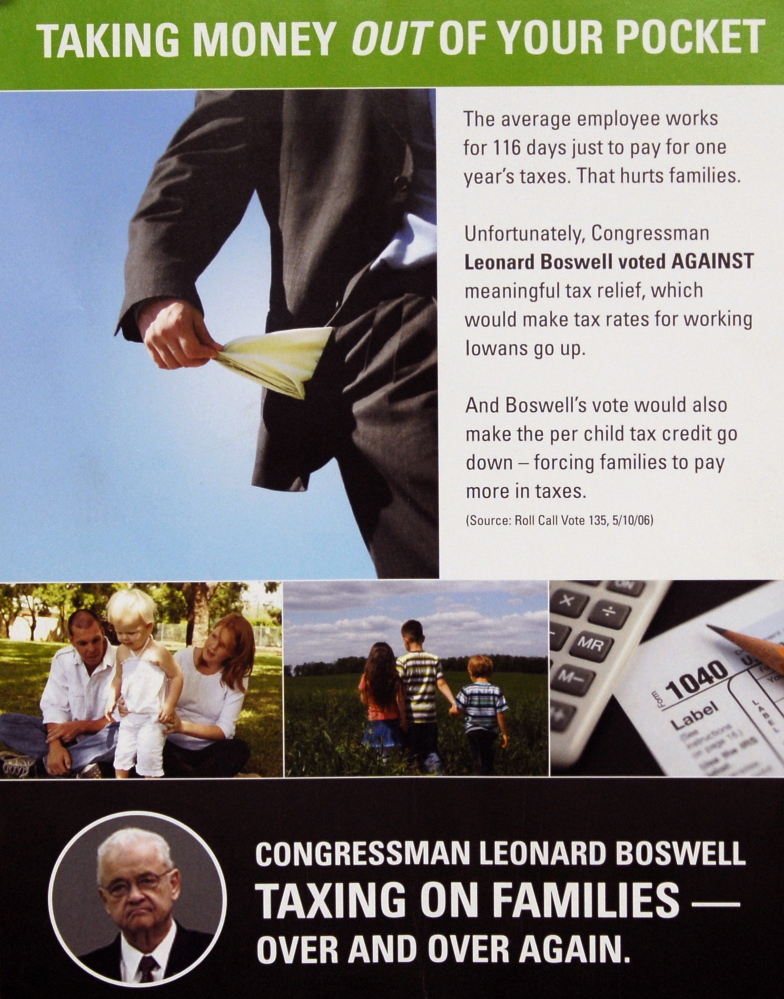WASHINGTON — It’s one thing to read that more than $1 billion has been spent to run 2.2 million television ads on congressional and gubernatorial races in the 2014 midterms.
It’s another thing to feel the deluge firsthand.
“I don’t believe in anything they’re saying, because they’re bashing each other,” said Jamie Aaron, 35, of Aurora, Colorado, as she loaded groceries into her car at a local supermarket. Aaron said she was so discouraged by the slashing attacks that she was not going to vote.
The overall volume of broadcast and national cable television ads is actually down slightly from the 2010 election, largely because fewer House races are in play, according to data from the ad-tracking service Kantar Media analyzed by the Wesleyan Media Project.
MORE ADS BACK DEMOCRATS
But states with competitive Senate races have been the scenes of major air battles, driving a 12 percent spike in the number of Senate ads this year compared with four years ago. By the end of last week, an estimated $410 million had been spent to air 907,900 ads in Senate races, according to the Center for Public Integrity’s analysis of Kantar Media data.
The big increase since 2010 has been in the number of ads supporting Democratic candidates. Those TV spots have been largely negative – 57 percent versus 47 percent of pro-Republican ads, according to the Wesleyan analysis.
For those who have been spared the onslaught, here’s a sampling of what it has been like, in order of least suffering to greatest:
– New Hampshire: 17,700 Senate spots aired since January 2013, $12 spent per eligible voter, according to the Center for Public Integrity.
Granite State residents are accustomed to political attack ads because of New Hampshire’s prominent role in presidential primaries, but even they got exasperated with the back-to-back spots between incumbent Sen. Jeanne Shaheen and challenger Scott Brown.
–Kansas: 25,300 spots, $5.17 spent per eligible voter. The contest between incumbent Sen. Pat Roberts and independent Greg Orman was slow to emerge as one of this year’s must-watch races. But once it did, there was a swarm of last-minute spending by independent groups on both sides.
– Colorado: 59,600 spots, $11 spent per eligible voter. Colorado has felt the brunt of ads aimed not only at the Senate matchup between incumbent Democrat Mark Udall and Republican Cory Gardner but also a gubernatorial campaign and major House contest.
– Alaska: 59,900 spots, $13 spent per eligible voter. At the tail end of the most expensive campaign in Alaskan history, Democratic Sen. Mark Begich made a pledge sure to have bipartisan appeal.
“Come Wednesday, no more TV commercials, I will make sure that happens,” he vowed, to cheers and whoops from his supporters.
– Arkansas: 60,600 spots, $12 spent per eligible voter. From the start, independent groups sought to set the terms of the race between incumbent Democratic Sen. Mark Pryor and GOP Rep. Tom Cotton, and by Tuesday they had poured more than $30 million into the campaign.
– Georgia: 65,000 spots, $6.26 spent per eligible voter. Turn on the TV or scan the radio dial and there is no way to escape it: Political advertising is everywhere in this state.
– Louisiana: 69,400 spots, $8.11 spent per eligible voter. More than three dozen super PACs, nonprofits and party committees piled into this race between Democratic Sen. Mary Landrieu and her GOP opponent, Bill Cassidy, spending $16 million, while the candidates together pumped $25 million into their campaigns, according to the Sunlight Foundation.
– North Carolina: 101,800 spots, $8.99 spent per eligible voter.
Many voters in North Carolina are well aware that their Senate race between Democratic incumbent Kay Hagan and challenger Thom Tillis is on track to be the most expensive in U.S. history – and, they say, they’re disgusted.
“I just don’t like all of the negativity,” said Cheresa Tucker, 41, who voted early and raised her hand during a Sunday morning service at St. Paul Baptist Church in Charlotte to volunteer to drive others to the polls Tuesday. “The entire theme of this election is negative; all of the ads are negative. It’s discouraging.”
During one local newscast Sunday night, three out of four commercials in one break were related to the Senate race.
Send questions/comments to the editors.




Success. Please wait for the page to reload. If the page does not reload within 5 seconds, please refresh the page.
Enter your email and password to access comments.
Hi, to comment on stories you must . This profile is in addition to your subscription and website login.
Already have a commenting profile? .
Invalid username/password.
Please check your email to confirm and complete your registration.
Only subscribers are eligible to post comments. Please subscribe or login first for digital access. Here’s why.
Use the form below to reset your password. When you've submitted your account email, we will send an email with a reset code.